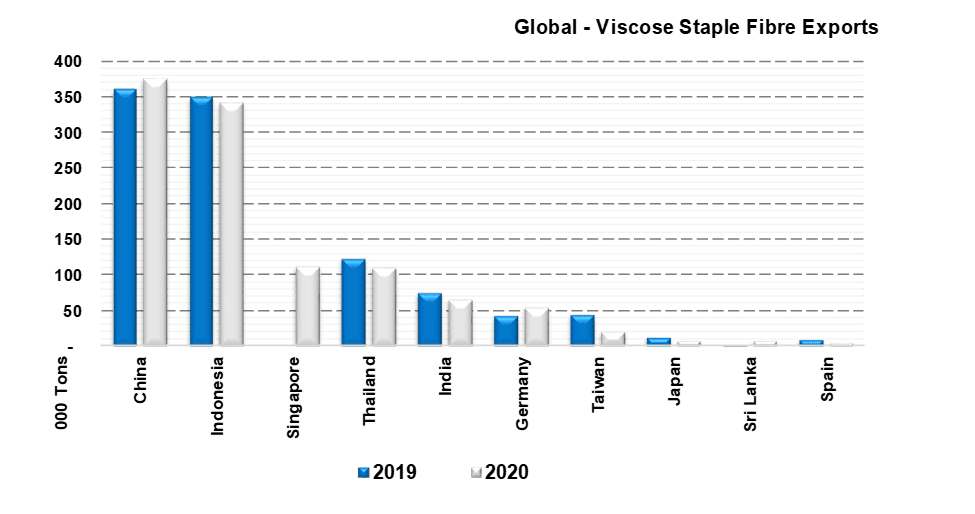PANDEMIC CREATES SHIFT IN VISCOSE IMPORT & EXPORT
Viscose stable fiber output was 578 million kg in 2019-20, which increased from 342 million kg in 2015-16. Viscose filament yarn output was 55 million kg in 2019-20. VSF production is more expensive than VFY production that explains why VSF imports and exports are more than VFY’s.
Viscose Staple Fiber (VSF), a natural, biodegradable fibre with characteristics similar to cotton, is made from wood pulp or cotton pulp. China’s VSF imports fell by 33 percent from 226 thousand tonnes in 2019 to 150 thousand tonnes in 2020. The United States’ imports climbed from 83 thousand tonnes in 2019 to 103 thousand tonnes in 2020. Singapore’s VSF import in 2020 was 98 thousand tonnes, barely 2 thousand tonnes higher than Bangladesh’s VSF import in the same year.
Bangladesh’s VSF imports increased by 60.97 percent, rising from 59 thousand tonnes in 2019 to 96 thousand tonnes in 2020. In 2020, India’s imports fell from 63 thousand tonnes in 2019 to 57 thousand tonnes. Vietnam’s imports in 2020 totalled to 49 thousand tonnes, ten thousand tonnes fewer than the previous year’s imports.
Germany’s VSF imports fell from 55 thousand tonnes in 2019 to 45 thousand tonnes in 2020, representing a 18 percent decrease. Indonesia’s imports fell precipitously from 53 thousand tonnes in 2019 to 36 thousand tonnes in 2020. Global VSF imports increased by only 2.65%.
VSF exports increased by 8.11 percent in 2020, well outpacing worldwide VSF imports. China was the largest VSF exporter, with an annual growth rate of 4.06 percent, as its shipments increased from 360 thousand tonnes in 2019 to 375 thousand tonnes in 2020. There was a notable disparity between Indonesia’s VSF imports and exports, as it was the world’s second largest exporter of VSF in 2020, with an export of 342 thousand tonnes, which was 7 thousand tonnes fewer than the export in 2019.
Despite being the second largest exporter. Singapore’s VSF export was 112 thousand tonnes, barely one thousand tonnes higher than Thailand’s export in the same year, 2020. Thailand’s exports fell, despite the fact that they were 12 thousand tonnes higher the prior year. India’s export was 76 thousand tonnes in 2019, however it fell to 66 thousand tonnes in 2020, resulting in a 12.17 percent reduction in annual VSF export growth. Germany’s exports increased by 28.47 percent, from 43 thousand tonnes in 2019 to 55 thousand tonnes in 2020. Taiwan’s export decreased from 45 thousand tonnes in 2019 to 21 thousand tonnes in 2020, which was less than half of the previous year’s export, with reduction in its yearly growth by 51.34 percent. Japan’s exports decreased from 13 thousand tonnes in 2019 to 9 thousand tonnes in 2020. Sri Lanka increased its exports in 2020 from 2,000 tonnes in 2019 to 8,000 tonnes in 2020. Spain’s exports fell from 9 thousand tonnes to 4 thousand tonnes in 2020. Malaysia’s exports increased by 228.57 percent in 2020, indicating a significant increase in the country’s exports.
China was the largest exporter in 2019 and 2020, with exports of 85 thousand tonnes and 71 thousand tonnes, respectively. The Czech Republic was the second biggest exporter in 2020, with shipments of 7,000 tonnes, which were 2,000 tonnes fewer than the previous year’s export for the same period. India exported 9 thousand tonnes of VFY in 2019 and 6 thousand tonnes in 2020, respectively. Poland, which was not at the top of the list of VSF importers and exporters, rose to fourth place in the list of VFY exporters for 2019 and 2020. Its exports were 6.8 thousand tonnes in 2019 and 4.8 thousand tonnes in 2010. Vietnam’s VFY exports were just 76 tons in 2019 that climbed up to 1716 tons in 2020. India’s export for the dwindled from 9,219 tons in 2019 to 6,066 tons in 2020.
Global VFY exports were 119 thousand tons in 2019 that decreased to 96 thousand tons in 2020.
Import & Export Data: 2018-2021.
(Man-Made Fibers & Yarns)


